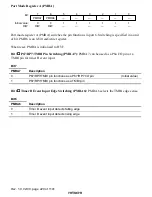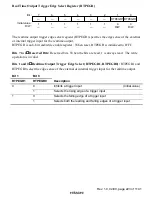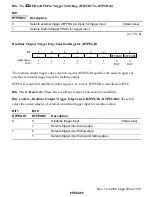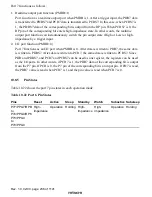
Rev. 1.0, 02/00, page 227 of 1141
•
Operation of the Realtime Output Port (PMR6 = 1)
When PMR6 is 1, it operates as a realtime output port. When a trigger is input, the PDR6 data
is transferred to PDRS6 and the PCR6 is transferred data to PCRS6, respectively. In this case,
when PCRS6 is 1, the PDRS6 data of the corresponding bit is output to the RP pin. When
PCRS6 is 0, the RP pin of the corresponding bit is output to the high-impedance state. In other
words, the pin output state (high or low) or high-impedance state can instantaneously be
switched by a trigger input.
Adversely, when PDR6 is read, the PDR6 values are read regardless of the PCR6 and PCRS6
values.
•
Operation of the general I/O port (PMR6 = 0)
When PMR6 is 0, it operates as a general I/O port. When data is written to PDR6, the same
data is also written to PDRS6. Accordingly, because both PDR6 and PDRS6 and both PCR6
and PCRS6 can be handled as one register, respectively, they can be used in the same way as a
normal general I/O port. In other words, if PCR6 is 1, the PDR6 data of the corresponding bit
is output to the P6 pin. If PCR6 is 0, the P6 pin of the corresponding bit becomes an input.
Adversely, assuming that PDR6 is read, the PDR6 values are read when PCR6 is 1 and the pin
values are read when PCR6 is 0.
10.7.5
Pin States
Table 10.19 shows the port 6 pin states in each operation mode.
Table 10.19 Port 6 Pin States
Pins
Reset
Active
Sleep
Standby
Watch
Subactive
Subsleep
P67/RP7 to
P60/RP0
P66/RP6/
$'75*
P65/RP5 to
P60/RP0
High-
impedance
Operation
Holding
High-
impedance
High-
impedance
Operation
Holding
Note:
If the TMBI and
$'75*
input pins are set, the pin level must be set to the high or low level
regardless of the active mode or low power consumption mode. Note that pin level must not
reach an intermediate level.















































